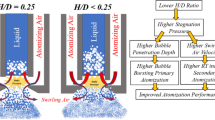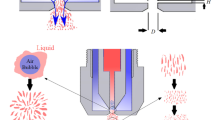Abstract
Compared to liquid jets/films from conventional air-blast injectors, flow blurring (FB) injection has generated fine sprays immediately at the injector exit, resulting in the clean combustion of various fuels including viscous oils. The FB atomization involves primary atomization by bubble bursting of the bubbly internal two-phase flow due to the dramatic pressure drop at the injector exit and the secondary break-up of droplets/ligaments by Rayleigh–Taylor instability. Recently, a novel swirl-burst (SB) injector has been developed to further enhance the secondary atomization, which has resulted in less lifted and cleaner flames by integrating swirling atomizing air with the FB concept. The present study investigates the effect of injector swirl number (ISN) on spray characteristics including droplet velocity and size distributions in the injector near field (8 mm × 4 mm) using particle image velocimetry and shadowgraph imaging for the SB injectors with diameter, D, of 1.5 mm. The study investigates four ISNs from 2.0 to 3.5 with an increment of 0.5, corresponding to various swirl vane angles. Results show that all the ISNs have achieved a short break-up length (~ 1.67D) and fine atomization with final droplet diameter ranging from 12 to 40 µm and SMD around 25 µm. Droplets are evenly distributed at each axial plane for all the ISNs. Increase in the ISN results in enhanced secondary atomization and hence finer droplets within 1.67D downstream of the injector exit. Spray angles are typically narrower at the increased ISN. Regardless of the variations within the injector near field and the different spray angles, the break-up length and final droplet size are nearly independent of the ISN.
Graphical abstract
















Similar content being viewed by others
References
Adrian RJ, Westerweel J (2011) Particle image velocimetry, 1st edn. Cambridge University Press, Cambridge
Bissell D, Lai W, Stegmeir M, Troolin D, Pothos S, Lengsfeld C (2014) An approach to spray characterization by combination of measurement techniques. Presented at ILASS Americas 26th Annual Conference on Liquid Atomization and Spray Systems, Portland
Chou WH, Hsiang LP, Faeth GM (1997) Temporal properties of drop breakup in the shear breakup regime. Int J Multiph Flow 23:651–669
Durdina L, Jedelsky J, Jicha M (2012) Spray structure of a pressure-swirl atomizer for combustion applications. EPJ Web Conf 25:01010. https://doi.org/10.1051/epjconf/20122501010
Fisher BT, Weismiller MR, Tuttle SG, Hinnant KM (2017) Effects of fluid properties on spray characteristics of a flow-blurring atomizer. Presented at the ASME Turbo Expo 2017: Turbomachinery Techincal Conference and Exposition, Combustion, Fuels and Emissions, Charlotte, North Carolina, USA
Gañán-Calvo AM (2005) Enhanced liquid atomization: from flow-focusing to flow-blurring. Appl Phys Lett 86:214101. https://doi.org/10.1063/1.1931057
Hung D, Harrington DL, Gandhi AH, Markle LE, Parrish SE, Shakal JS, Sayar H, Cummings SD, Kramer JL (2008) Gasoline fuel injector spray measurement and characterization—a new sae recommended practice. SAE Tech Pap Ser. https://doi.org/10.4271/2008-01-1068
Jahanmiri M (2011) Particle image velocimetry: fundamentals and its applications. Chalmers University of Technology, Goteborg. https://pdfs.semanticscholar.org/019f/d4139e6e3b99784eda8f5af23a9cfd3be295.pdf. Accessed 17 Dec 2018
Jain S, Somasundaram S, Anand TNC (2016) A fluorescent laser-diffuser arrangement for uniform backlighting. Meas Sci Technol 27:025406. https://doi.org/10.1088/0957-0233/27/2/025406
Jiang L, Agrawal AK (2014) Combustion of straight glycerol with/without methane using a fuel-flexible, low-emissions burner. Fuel 136:177–184
Jiang L, Agrawal AK (2015a) Spray features in the near field of a flow–blurring injector.pdf. Exp Fluids 56:103. https://doi.org/10.1007/s00348-015-1973-z
Jiang L, Agrawal AK (2015b) Investigation of glycerol atomization in the near-field of a flow-blurring injector using time-resolved PIV and high-speed visualization. Flow Turbul Combust 94:323–338. https://doi.org/10.1007/s10494-014-9572-2
Jiang L, Agrawal AK, Taylor RP (2014) Clean combustion of different liquid fuels using a novel injector. Exp Therm Fluid Sci 57:275–284
Jiang L, Akinyemi OS, Danh V (2017) Investigation of combustion characteristics of straight vegetable oil for a novel twin-fluid fuel injector. In: Presented at the 10th US National Combustion Meeting, Maryland
Keane RD, Adrian RJ (1992) Theory of cross-correlation analysis of PIV images. Appl Sci Res 49:191–215. https://doi.org/10.1007/BF00384623
Khandelwal B, Lili D, Sethi V (2014) Design and study on performance of axial swirler for annular combustor by changing different design parameters. J Energy Inst 87:372–382. https://doi.org/10.1016/j.joei.2014.03.022
Kourmatzis A, Lowe A, Masri AR (2016) Combined effervescent and airblast atomization of a liquid jet. Exp Therm Fluid Sci 75:66–76. https://doi.org/10.1016/j.expthermflusci.2016.02.002
Lefebvre AH (1980) Airblast atomization. Prog Energy Combust Sci 6:233–261. https://doi.org/10.1016/0360-1285(80)90017-9
Lefebvre AH (1988) A novel method of atomization with potential gas turbine applications. Def Sci J 38:353–362
Lefebvre AH, McDonell VG (2017) Atomization and sprays, 2nd edn. Taylor & Francis, Boca Raton
Lilley DG (1977) Swirl flows in combustion: a review. AIAA J 15:1063–1078. https://doi.org/10.2514/3.60756
Liu C, Liu F, Yang J, Mu Y, Hu C, Xu G (2018) Experimental investigations of spray generated by a pressure swirl atomizer. J Energy Inst 92(2):210–221
Niguse YG, Agrawal AK, Taylor RP, Cox WF (2013) A novel fuel-flexible combustor for industrial applications. Presented at AFRC Industrial Combustion Symposium, Hawaii
Ohnesorge W (1936) Formation of drops by nozzles and the breakup of liquid jets. Z Angew Math Mech 16:355–358
Panchagnula MV, Sojka PE (1999) Spatial droplet velocity and size profiles in effervescent atomizer-produced sprays. Fuel 78:729–741
Panchasara H, Sequera D, Schreiber W, Agrawal AK (2009) Emission reductions in diesel and kerosene flames using a novel fuel injector. J Propuls Power 25:984–986
Roudini M, Wozniak G (2018) Experimental investigation of spray characteristics of pre-filming air-blast atomizers. J Appl Fluid Mech 11:1455–1469
Simmons BM, Agarwal AK (2012) Flow blurring atomization for low-emission combustion of liquid biofuels. Combust Sci Technol 184:660–675
Urbán A, Zaremba M, Malý M, Józsa V, Jedelský J (2017) Droplet dynamics and size characterization of high-velocity airblast atomization. Int J Multiph Flow 95:1–11. https://doi.org/10.1016/j.ijmultiphaseflow.2017.02.001
Weber C (1931) Disintegration of liquid jets. Z Angew Math Mech 11:136–159
Xue J, Jog MA, Jeng SM, Steinthorsson E, Benjamin MA (2004) Effect of geometric parameters on simplex atomizer performance. AIAA J 42:2408–2415. https://doi.org/10.2514/1.2983
Zhang T, Dong B, Chen X, Qiu Z, Jiang R, Li W (2017) Spray characteristics of pressure-swirl nozzles at different nozzle diameters. Appl Therm Eng 121:984–991
Acknowledgements
This research was funded by the University of Louisiana at Lafayette Startup Fund and Louisiana Transportation Research Center [Grant number, 17-3TIRE].
Author information
Authors and Affiliations
Corresponding author
Additional information
Publisher’s Note
Springer Nature remains neutral with regard to jurisdictional claims in published maps and institutional affiliations.
Rights and permissions
About this article
Cite this article
Danh, V., Akinyemi, O.S., Taylor, C.E. et al. Effect of injector swirl number on near-field spray characteristics of a novel twin-fluid injector. Exp Fluids 60, 80 (2019). https://doi.org/10.1007/s00348-019-2721-6
Received:
Revised:
Accepted:
Published:
DOI: https://doi.org/10.1007/s00348-019-2721-6




